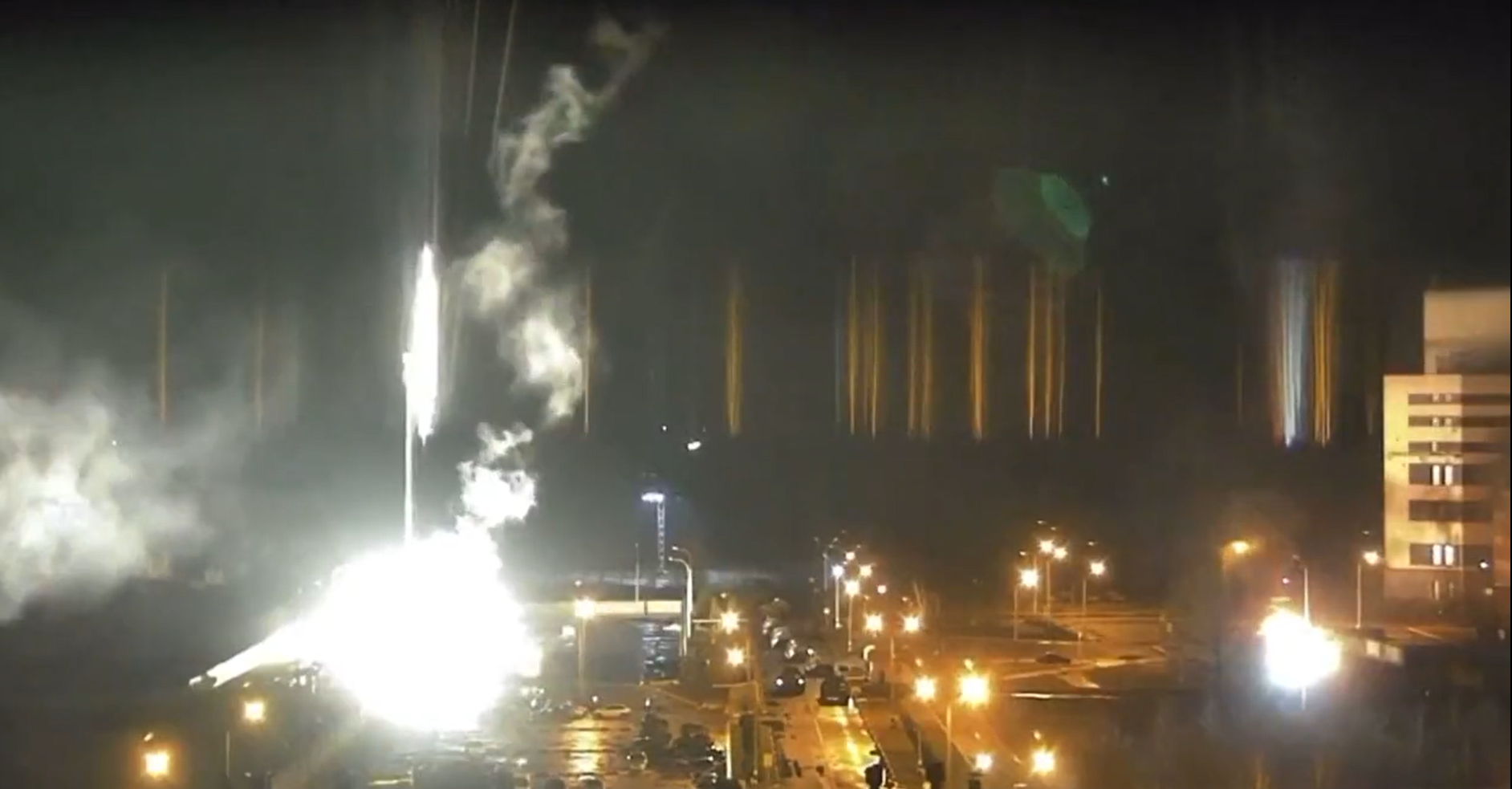
At approximately 2:50am local time, local news reported a fire at the Zaporizhzhya nuclear power plant in Energodar, south-east Ukraine.
Ukraine’s foreign minister shared security camera footage from the power plant online. The video appears to show a brightly burning object falling to the ground from out of frame, followed by growing smoke clouds. The minister appealed to Russian forces to fight the fire, for fear of another Chernobyl-scale disaster.
Zaporizhzhia NPP is under fire! The entire Europe is at risk of a repeat of the nuclear catastrophe. Russians must stop fire! pic.twitter.com/P46YxKZZ0W
— Михайло Подоляк (@Podolyak_M) March 4, 2022
At approximately 3:30am local time, the International Atomic Energy Agency (IAEA) announced that director general Rafael Mariano Grossi had spoken to Ukrainian Prime Minister Denys Shmygal. Soon after, the agency reported no change to radiation readings taken at the site by Ukraine’s nuclear regulator.
At 3:47am, Ukrainian President Volodymyr Zelensky released a short video criticising Russia for firing on the nuclear plant. The president also said that he did not know how the fire would end. He continued: “Right now, Russian tanks are firing at the nuclear units. These tanks are equipped with thermal imagers. So they know where they are shooting.
“No state in history has ever fired on a nuclear power plant. For the first time in the history of humanity, the terrorist state [Russia] has resorted to nuclear terrors.” Ukrainian news then alleged that a paramilitary organisation had broken into the plant to use it defensively.
How well do you really know your competitors?
Access the most comprehensive Company Profiles on the market, powered by GlobalData. Save hours of research. Gain competitive edge.

Thank you!
Your download email will arrive shortly
Not ready to buy yet? Download a free sample
We are confident about the unique quality of our Company Profiles. However, we want you to make the most beneficial decision for your business, so we offer a free sample that you can download by submitting the below form
By GlobalDataAt approximately 4am, Ukraine’s state emergency services said that the fire had spread through the top three floors of a training building. However, Russian forces would not allow Ukrainian firefighters access to the site.
Окупанти не дають можливості для підрозділів ДСНС приступити до ліквідації наслідків пожежі.
— Ukrinform (@UKRINFORM) March 4, 2022
У м. Енергодар на Запорізькій АЕС працює один енергоблок із шести.
Протипожежний стан АЕС в нормі.
Essential equipment remains undamaged, but the IAEA has readied its Incident and Emergency Centre to respond at all times in reaction to the fire.
US President Joe Biden spoke directly to Zelenskyy about the fire later in the night. Before 4.30am Ukraine time, the US and UK Governments both issued statements expressing concern at the fire and nearby fighting. Later, the US said that the plants reactors were being shut down for safety. The UK has requested an emergency UN security council session to discuss events at the plant.
Local news reports that at approximately 5.20am, 40 firefighters have been allowed access to the site.
Comparisons with Chernobyl, and nuclear security at war
The power plant lies near the front lines of Russia’s invasion of Ukraine from the south, with fighting reported in Energodar in recent days. The 6GW Zaporizhzhya Nuclear Power Plant began operating in 1984 and now has six reactors, five of which remain offline for maintenance. It is the largest of Ukraine’s four operational nuclear power plants, and the largest nuclear site in Europe. These four plants host 15 reactors, more than half of continue to operate at full capacity.
Immediate comparisons with the Chernobyl disaster have increased concern around the incident, but at time of writing no evidence has yet suggested the compromise of nuclear material.
The meltdown and fire of the Chernobyl plant was the first recorded level 7 nuclear disaster, taking place in 1986. The site lies more than 300 miles (500km) from Zaporizhzhya, in the north of the country. The larger generation capacity of the Zaporizhzhya plant has led some to claim that a nuclear incident at the plant would be significantly more damaging than Chernobyl. However, this claim ignores the massive impact that reactor design, operational processes, and weather have on nuclear material dispersal.
Russia’s invasion of Ukraine has caused concern over the security of nuclear sites. A small radiation spike in the area surrounding Chernobyl accompanied its capture by Russian forces. However, Grossi has said that the army’s occupation of the site has meant workers “have limited opportunities to communicate, move, and carry out full-fledged maintenance and repair work”.
Since Russia captured the Chernobyl exclusion zone and reactor remains on 24 February, staff have not been allowed to leave. This has led to “psychological pressure and moral exhaustion”.
The destruction of one of two power lines supplying the site has also caused inconvenience. However, backup generators remain functional and the site does not require power to prevent further contamination.
Commenting on this, Grossi said: “Any accident caused as a result of the military conflict could have extremely serious consequences for people and the environment, in Ukraine and beyond.”



